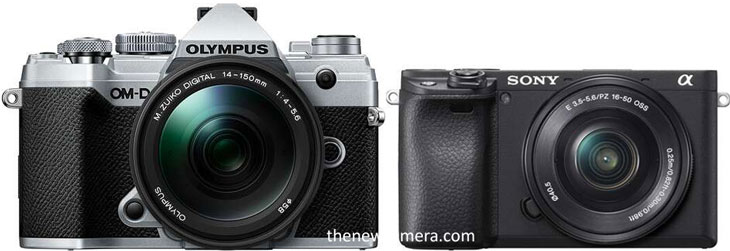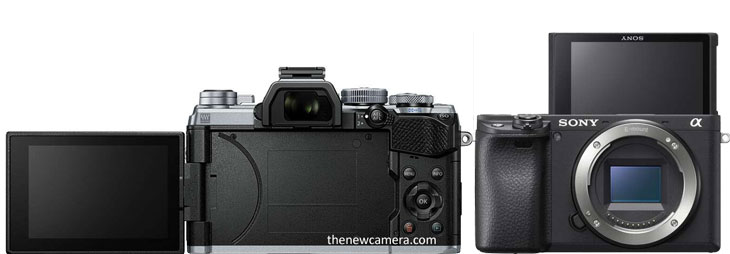
Let’s talk about the specification comparison between the Sony A6400 camera and the Olympus E-M5 III camera. ow before we begin let me tell you that we ony do carry a large sensor inside it. If, you are someone who mainly shoots still images only. Then without moving into details my suggestion is you should buy the Sony A6400 with IMX 271 APS-C Exmor CMOS sensor.
With the Sony 24 MP sensor you will be getting more more bit depth, more dynamic range, better color output and more clean low-light images when paired with bright aperture lenses.
Sensor Details
| Olympus E-M5 | Sony A6400 | |
| Lens Mount | Micro Four Thirds | Sony E |
| Camera Format | Micro Four Thirds (2x Crop Factor) | APS-C (1.5x Crop Factor) |
| Pixels | Actual: 21.8 Megapixel Effective: 20.4 Megapixel |
Actual: 25 Megapixel Effective: 24.2 Megapixel |
| Maximum Resolution | 5184 x 3888 | 6000 x 4000 |
| Aspect Ratio | 4:3 | 3:2, 16:9 |
| Sensor Type | MOS | CMOS |
| Sensor Size | 17.4 x 13 mm | 23.5 x 15.6 mm |
| Image File Format | JPEG, RAW | JPEG, RAW |
| Bit Depth | 12-Bit | 14-Bit |
| Image Stabilization | Sensor-Shift, 5-Axis | None |
Sensor Image stabilization missing inside Sony A6400
The selling point of Olympus apart from DCI 4k is built-in image stabilization. The camera features 5.5 Stops of butil-in image stabilization system which can be further enhanced upto 6.5 stops when paired with the OSS lenses. With Sony you have to depend upon broad ISO range and OSS lenses for getting clear shots at night.
Large Sensor area and better ISO range in Sony A6400
The ISO range of the Sony A6400 camera is more than of the new Olympus E-M5 Mark III camera. The expandable ISO range of Sony is 2 stops more than of the Oly. More or less we are also getting larger sensor are with Sony APS-C sensor. So, be assured you will get better low-light performance with the Sony A6400.
Exposure
| Olympus E-M5 Mark III | Sony A6400 | |
| ISO Sensitivity | Auto, 200 to 25600 (Extended: 64 to 25600) | 100 to 32000 (Extended: 100 to 102400) |
| Shutter Speed | Mechanical Shutter 1/8000 to 60 Second 0 to 3 Hour in Bulb Mode Electronic Front Curtain Shutter 1/320 to 60 Second Electronic Shutter 1/32000 to 60 Second |
Electronic Front Curtain Shutter 1/4000 to 30 Seconds Bulb Mode |
| Metering Method | Center-Weighted Average, Multi-Zone, Spot | Average, Center-Weighted Average, Highlight Weighted, Multi-Zone, Spot |
| Exposure Modes | Aperture Priority, Auto, Manual, Program, Shutter Priority | Aperture Priority, Auto, Manual, Program, Shutter Priority |
| Exposure Compensation | -5 to +5 EV (1/3, 1/2, 1 EV Steps) | -5 to +5 EV (1/3, 1/2 EV Steps) |
| Metering Range | -2 to 20 EV | -2 to 20 EV |
| White Balance | Auto, Color Temperature | Auto, Cloudy, Color Temperature, Color Temperature Filter, Custom, Daylight, Flash, Fluorescent (Cool White), Fluorescent (Day White), Fluorescent (Daylight), Fluorescent (Warm White), Incandescent, Shade, Underwater |
| Continuous Shooting | Up to 10 fps at 20.4 MP for up to 150 Exposures (Raw) Up to 10 fps at 20.4 MP for Unlimited Exposures (JPEG) Up to 6 fps at 20.4 MP for Unlimited Exposures (Raw) Up to 6 fps at 20.4 MP for Unlimited Exposures (JPEG) Up to 30 fps at 20.4 MP for up to 23 Exposures (Raw) Up to 30 fps at 20.4 MP for up to 26 Exposures (JPEG) |
Up to 11 fps at 24.2 MP for up to 46 Exposures (Raw) Up to 11 fps at 24.2 MP for up to 116 Exposures (JPEG) Up to 11 fps at 24.2 MP for up to 115 Exposures (JPEG) Up to 11 fps at 24.2 MP for up to 99 Exposures (JPEG) |
| Interval Recording | Yes | Yes |
| Self-Timer | 2/12-Second Delay | 2/5/10-Second Delay |
DCI vs UHD Despite of having a smaller sensor the camera is able to grab out DCI 4k videos whereas the Sony A6400 camera records slightly lower resolution UHD 4K videos from a large APS-C sensor.
Limit vs No-Limit: Sony offers unlimited video recording option. with Olympus we do have the traditional 30min video recording limit. So, of course Sony is bit better for longer run.
Video AF Test Below
| Olympus E-M5 Mark III | Sony A6400 | |
| Recording Modes | MOV/H.264 DCI 4K (4096 x 2160) at 24.00p [237 Mb/s] UHD 4K (3840 x 2160) at 23.976p/25p/29.97p [102 Mb/s] Full HD (1920 x 1080) at 23.976p/25p/29.97p/50p/59.94p/119.88p [18 to 202 Mb/s] HD (1280 x 720) at 23.976p/25p/29.97p/50p/59.94p [10 to 102 Mb/s] |
XAVC S UHD 4K (3840 x 2160) at 24.00p/25p/29.97p [60 to 100 Mb/s] Full HD (1920 x 1080) at 100p/119.88p [60 to 100 Mb/s] Full HD (1920 x 1080) at 24.00p/25p/29.97p/50p/59.94p [50 Mb/s] Full HD (1920 x 1080) at 50p/59.94p [25 Mb/s] Full HD (1920 x 1080) at 25p/29.97p [16 Mb/s] AVCHD Full HD (1920 x 1080) at 50i/59.94i [17 to 24 Mb/s] |
| External Recording Modes | 4:2:2 8-Bit DCI 4K (4096 x 2160) up to 24.00p |
4:2:2 8-Bit UHD 4K (3840 x 2160) at 24.00p/25p/29.97p Full HD (1920 x 1080) at 24.00p/50i/50p/59.94i/59.94p |
| Recording Limit | Up to 29 Minutes | NO LIMIT |
| Video Encoding | NTSC/PAL | |
| Audio Recording | Built-In Microphone (Stereo) External Microphone Input (Stereo) |
Built-In Microphone (Stereo) External Microphone Input |
Video AF
Video AF is one of the most important thing for Sony A6400 camera. If you have time look at the AF test videos one by one and you will get a clear idea who does better AF. Hint: Sony A6400 AF is just incredible.
Video AF Test of Sony A6400
Video AF Test of the Olympus E-M5 III
So, from the test videos you can clearly see that, Sony is doing better AF than of the Olympus E-M5 III camera. So, if you are video vlogger than you should move with the Sony A6400 camera.
AutoFocus
| Olympus E-M5 Mark III | Sony A6400 | |
| Focus Type | Auto and Manual Focus | Auto and Manual Focus |
| vFocus Mode | Continuous-Servo AF (C), Manual Focus (M), Single-Servo AF (S) | Automatic (A), Continuous-Servo AF (C), Direct Manual Focus (DMF), Manual Focus (M), Single-Servo AF (S) |
| Autofocus Points | Phase Detection: 121 (121 Cross-Type) Contrast Detection: 121 |
Phase Detection: 425 Contrast Detection: 425 |
| -2 to +20 EV |
With Sony A6400 camera we are getting 2X more AF points as well as more AF coverage. So, Sony A6400 camera will do better AF than of the Olympus E-M5 Mark III camera.

Viewfinder and display
| Olympus E-M5 Mark III | Sony A6400 | |
| Viewfinder Type | Electronic (OLED) | Electronic |
| Viewfinder Resolution | 2,360,000 Dot | 0.39″ |
| Viewfinder Eye Point | 27 mm | 23 mm |
| Viewfinder Coverage | 100% | 100% |
| Viewfinder Magnification | Approx. 0.67x | Approx. 1.07x |
| Diopter Adjustment | -4 to +2 | -4 to +3 |
| Monitor Size | 3″ | 3″ |
| Monitor Resolution | 1,040,000 Dot | 921,600 Dot |
| Monitor Type | Articulating Touchscreen LCD | 180° Tilting Touchscreen LCD |
Vari-angle Screen is an additional advantage: Having a vari-angle screen in a camera is highly required when you are vlogging with the camera. In general when you put Microphone on hotshoe the SOny A6400 screen gets blocked and you have to use slightly modified Microphones available in the market.
Card slots and more
| Olympus E-M5 Mark III | Sony A6400 | |
| Memory Card Slot | Single Slot: SD/SDHC/SDXC (UHS-II) | Single Slot: SD/SDHC/SDXC/Memory Stick Duo Hybrid (UHS-I) |
| Connectivity | Micro-B (USB 2.0), HDMI D (Micro), 2.5mm Sub-Mini, 3.5mm Microphone | 3.5mm Microphone, HDMI D (Micro), Wired Remote Port, Micro-B (USB 2.0) |
| Wireless | Bluetooth Wi-Fi |
Wi-Fi |
| GPS | No | No |
weight and size
| Olympus E-M5 Mark III | Sony A6400 | |
| Battery | 1 x BLS-50 Rechargeable Lithium-Ion, 7.2 VDC, 1175 mAh (Approx. 310 Shots) | 1 x NP-FW50 Rechargeable Lithium-Ion, 7.2 VDC, 1080 mAh |
| Dimensions (W x H x D) | 4.93 x 3.35 x 1.96″ / 125.3 x 85.2 x 49.7 mm | 4.7 x 2.6 x 2.4″ / 120 x 66.9 x 59.7 mm |
| Weight | 14.6 oz / 414 g (Body with Battery and Memory) | 14.22 oz / 403 g (Body with Battery and Memory) |
Olympus E-M5 Mark III vs Sony A6400 Verdict / Conclusion:
Sony A6400 For Still Shooters
For still shooter we recommend you to go with Sony A6400 camera. Since, Sony features large APS-C Sensor with more dynamic range and better low-light performance.
Best Lenses for Still shooters
Best Lenses for Sony A6400
Best Lenses for Olympus E-M5 III Camera
| 1. Best Standard Zoom Lens (Best all in one) | Olympus 12-40mm f/2.8 Pro ($799 for the kit) |
| Option #2 afforable | Olympus 12-50mm f/3.5-6.3 ($499) |
| 2. Best Wide angle Zoom Lens | Panasonic Lumix 7-14mm f/4.0 ($881) |
| 3. Wide angle Prime (portraits / vlogs) | Olympus 17mm f/2.8 ($349) |
| 4. Best Zoom Lens | Olympus 40-150mm f/4.0-5.6 ($119) |
| 5. Best Macro Lens | Olympus 60mm f/2.8 ($449) |
For Video vloggers you have we have to compared their feature once again
Best Vlogging Camera between Olympus E-M5 Mark III vs Sony A6400
| Olympus E-M5 Mark III | Sony A6400 | |
| Video | DCI 4k | UHD 4K |
| Display | Vari-angle Touch | Front-Flip Touch Screen |
| Video Recording Limit | 30Min | Unlimited |
| Camera IS | 5.5 Stops | No in camera IS [OSS Lens required] |
| Video AF | Sony A6400 considerably fast than Olympus E-M5 Mark III in Video AF | |
| Lenses based IS | Most of the Olympus Lenses doesn’t have IS. Only telephoto lenses have. | Sony Kit lens have IS as well as Sony 10-18 F4 OSS vlogging lens also have IS. |
| Microphones | You can use literally any microphones due to nature of var-angle display screen. | Recommended Rode Lavalier GO Omnidirectional Lavalier Microphone for Wireless GO System Rode VideoMicro Ultracompact Camera-Mount Shotgun Microphone |
Which is more annoying to you Slow Video AF while Vlogging or a bit Camera shake while walking ?
So, in this case I will pick Sony A6400 camera since, I always want to have bang-on focus when I am creating youtube content. I am not always walking and more than 70% of video are done in my room. So, for me Sony A6400 is a excellent camera for vlogging puspose.
Recommended Vlogging Setup for both camera
Sony A6400 is a killer vlogging combo when paired up with kit lens or Sony 10-18 F4 OSS vlogging lens. For sound you can use Rode Lavalier OR while on move you can use Rode VideoMicro Ultracompact shotgun.
Olympus is a Excellent vlogging combo when paired up with kit lens or Olympus 17mm f/2.8. You can use Rode Lavalier or Rode shotgun microphone of your choice.






